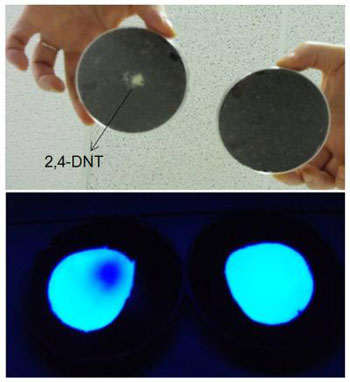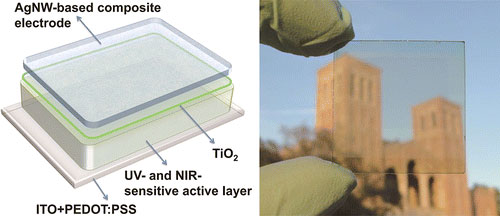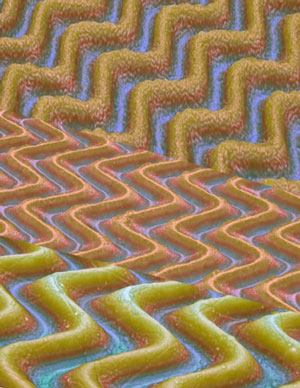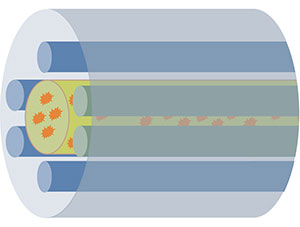BASF SE, Heidelberger Druckmaschinen AG (Heidelberg), and TU Darmstadt are pleased with the results of the first phase of the joint research project "Nanostructuring and plastic electronics print platform" (NanoPEP) and have agreed to continue their joint work.
Aug 2nd, 2012
Read more
Scientists from A*STAR's Institute of Materials Research and Engineering (IMRE) will partner companies to develop, prototype and conduct pilot large scale manufacturing of nanoimprinted materials with better performance and at potentially lower cost than current production methods.
Aug 2nd, 2012
Read more
Researchers from the NIST Center for Nanoscale Science and Technology have used three-dimensional single-particle tracking to measure the dynamic behavior of individual nanoparticles adsorbed at the surface of micrometer-scale oil droplets in water.
Aug 2nd, 2012
Read more
Direct imaging by Berkeley Lab researchers confirms the importance of electron-electron interactions in graphene.
Aug 2nd, 2012
Read more
 A chemical sensing system developed by engineers at the University of Connecticut is believed to be the first of its kind capable of detecting vapors from buried landmines and other explosive devices with the naked eye rather than advanced scientific instrumentation.
A chemical sensing system developed by engineers at the University of Connecticut is believed to be the first of its kind capable of detecting vapors from buried landmines and other explosive devices with the naked eye rather than advanced scientific instrumentation.
Aug 2nd, 2012
Read more
A current dogma in the field of cell migration is that actin polymerization and actomyosin contractility give cells the flexibility they need to protrude and contract across a matrix in order to migrate.
Aug 1st, 2012
Read more
 New technique using kinetic inductance shows promise for dramatic miniaturization of metamaterials.
New technique using kinetic inductance shows promise for dramatic miniaturization of metamaterials.
Aug 1st, 2012
Read more
Researchers initiated the 'Control of assembly and charge transport properties of immobilized DNA' (CIDNA) project in order to apply imaging technology of extremely high spatial and temporal resolution to study charge transfer through immobilized DNA.
Aug 1st, 2012
Read more
An EU-funded initiative has integrated Europe's software and infrastructure resources to create a high-tech platform for use in the area of structural genomics.
Aug 1st, 2012
Read more
EU-funded researchers used the body's molecular army and nanotechnology to create a low-cost and portable immunosensor platform with infinite diagnostic possibilities.
Aug 1st, 2012
Read more
 Scientists are reporting development of a new transparent solar cell, an advance toward giving windows in homes and other buildings the ability to generate electricity while still allowing people to see outside.
Scientists are reporting development of a new transparent solar cell, an advance toward giving windows in homes and other buildings the ability to generate electricity while still allowing people to see outside.
Aug 1st, 2012
Read more
To help people work safely with carbon nanotubes, Safe Work Australia commissioned the Commonwealth Scientific and Industrial Research Organisation (CSIRO) to develop the guidance document Safe Handling and Use of Carbon Nanotubes.
Aug 1st, 2012
Read more
Applied onto the business end of artificial skin, nanofilms that release antibacterial silver over time can eradicate bacteria in full-thickness skin wounds in mice.
Aug 1st, 2012
Read more
 MIT team discovers way of making perfectly ordered and repeatable surfaces with patterns of microscale wrinkles.
MIT team discovers way of making perfectly ordered and repeatable surfaces with patterns of microscale wrinkles.
Aug 1st, 2012
Read more
Using the correct annealing temperature is key to making fast, non-volatile computer memory.
Aug 1st, 2012
Read more
 Hollow optical fibers containing light-emitting liquids hold big promises for biological sensing applications.
Hollow optical fibers containing light-emitting liquids hold big promises for biological sensing applications.
Aug 1st, 2012
Read more






 Subscribe to our Nanotechnology News feed
Subscribe to our Nanotechnology News feed